The White House was not always the White House. It was officially named by President Theodore Roosevelt in 1901. It was previously known as the President’s Palace, the President’s House or the Executive Mansion. It started out much smaller and expanded. About 10,000 people visit the most famous presidential palace in the world every week. Starting this Monday, the visit becomes even more of a history lesson, after a project led by the first lady, Jill Biden, to provide it with greater educational content. On Sunday, at a dinner to celebrate the reform, the president of the United States, Joe Biden, said that he was not surprised that his wife, a teacher for 40 years and who continues to practice at 73, he would have wanted to turn the White House into “an inspiring educational opportunity” for everyone. “In the United States we do not erase history. We celebrate it,” he said.
The first lady presented the new improved route this Monday. “To preserve our history, we must teach it. We learn from the wisdom of the past and incorporate it into our future. And when you walk through this house, I hope you feel the history that is here. It is your story and it lives in each one of you, connecting you with those who have gone before you and with others,” he said.
Jill Biden herself now welcomes visitors at the entrance to the East Wing on a vertical screen in which she is seen almost life-size, after walking through a hallway in which the construction of the mansion and the construction of the mansion are reviewed on new digital devices. who have been its occupants. A model on the wall illuminates in parts to indicate the different renovations and expansions that the complex has undergone in its more than two centuries of history, one of the first lady’s favorite novelties, as she confessed.
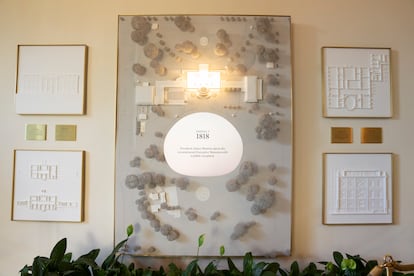
The new visit not only incorporates more educational and attractive elements along the route, focusing on technology and digital components, but also facilitates greater access to the facilities. The big news is that the Diplomatic Reception Room, used to receive foreign dignitaries, is opened to the public for the first time. From there he gave his famous fireside talks to President Franklin Delano Roosevelt (FDR). A recreation of a 1939 Philco radio plays excerpts from several fireside talks given by FDR during his presidency.
This Monday he was heard, for example, explaining the declaration of war on Japan on December 9, 1941, which marked the entry of the United States into World War II. “We are now in a war not for conquest, not for revenge, but for a world in which this country, and everything this country represents, is safe for our children,” his voice sounded.
In addition, you can now enter several rooms that previously could only be seen from the doorway, such as the library, the porcelain room and the Golden Room, which houses a collection of Vermeil silver (silver gilt). , all of them on the ground floor.
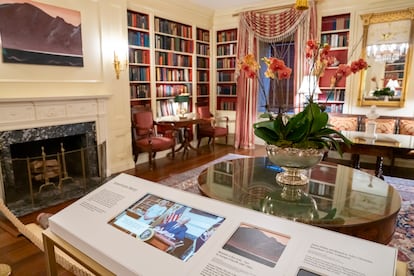
Signage has improved throughout the visit. The new educational content updates the 18 introductory signs to the rooms, with an additional six to point out new elements of the tour. When you enter each room, there are multi-sensory panels, with educational information and tactile content. They detail the historical uses of each room and point out the most notable objects. The ability to touch replicas of the materials provides a new experience for visitors and improves accessibility for people who are blind or have low vision.
Jill Biden celebrated the news this Monday. “Have any of you ever walked through a museum and wanted to touch one of the pieces on display? Have you ever listened to a recording from years ago and suddenly felt like you were in that room, like the present and the past came together? Have you ever seen a photo of someone famous and has it helped you understand that person a little better?” he asked the audience. “That’s what I had in mind when creating this tour updated from the White House.”
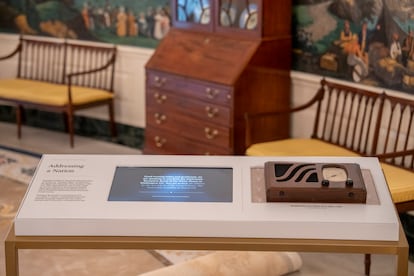
“As a teacher for 40 years, I know that we all learn in different ways. Some of us learn by listening, others by feeling. So we’ve added dynamic, flexible and tactile learning tools that allow you to satisfy your curiosity. Now you can do all the things you always wanted to do in a museum. We have made replicas so that you can feel the features of the faces of some sculptures and touch the shiny fabric of the furniture in the Blue Room. Now you can listen to President Roosevelt’s fireside chats in the room where he recorded them, so you feel like you’re right there at his side. “We have added screens and information so you can read about what you see in each of the rooms for visual learners,” he continued.
A message from Biden
Upon ascending to the so-called State floor and entering the East Room, it is the president, Joe Biden, whose term ends on January 20, who greets visitors on a vertical screen. “I hope you believe that you can achieve anything, even become president one day,” he says in a message especially addressed to students. The East Room is the place from which the president appears most frequently along with the Oval Office, not included in the visit. This is the broadest dependency. With the portraits of George and Martha Washington, it is an open-plan room, to accommodate every occasion, from press conferences to Christmas or wedding celebrations. It has also served as a memorial service for seven of the eight American presidents who died in office, including Abraham Lincoln, Franklin D. Roosevelt and John F. Kennedy.
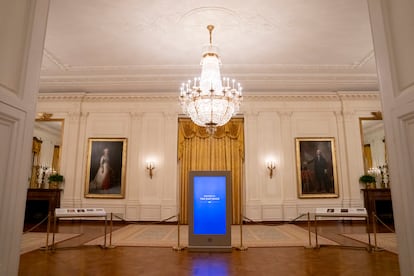
Visitors then tour the Green Room (which Thomas Jefferson used as a dining room), the Red Room (where Ulysses Grant liked to recount his war battles), the Blue Room (with the windows overlooking the south lawn of the White House) and the State Dining Room. The latter is dominated by the portrait of Abraham Lincoln, assassinated in 1865, as the Civil War neared its end. That place was initially Thomas Jefferson’s office, but since James Madison (1809-1817) it has served for state lunches and dinners and celebrations of the first family. Theodore Roosevelt expanded it in the 1902 renovation so that it could seat up to 140 guests. At the time it was decorated with animal heads as trophies, including a large elk head above the fireplace.
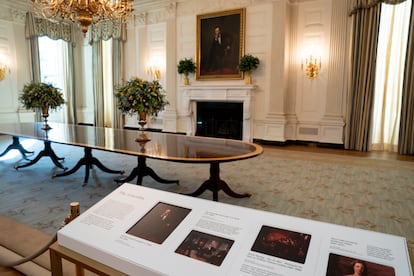
The visit ends in the wide hallway (Cross Hall) and the main lobby area (Grand Foyer), decorated with portraits of the presidents. Located near the landing of the Grand Staircase, another large vertical screen plays to show rotating images taken at that same point of special events at the White House, at weddings, state dinners and other special occasions.
Americans can request to visit the presidential palace through the White House website or through the office of the corresponding member of the House of Representatives or senator. In the case of foreigners, the request must be channeled through the country’s embassy in Washington. Apart from the Oval Office, the visit to the White House for tourists does not include the family rooms on the upper floors in the East Wing or the executive rooms in the West Wing. In total, there are 132 rooms and 35 bathrooms in the building on its six levels, including basements.
Multiple reforms
The first president, George Washington, selected the site for the White House in 1791. The following year, the cornerstone was laid and a design by Irish architect James Hoban was chosen. After eight years of construction, President John Adams and his wife Abigail moved into the still-unfinished residence. Since then, it has been occupied by every president. During the War of 1812, the British burned the president’s house and Hoban was appointed to rebuild it. James Monroe moved into the building in 1817 and during his administration the South Portico was built. In 1829, Andrew Jackson oversaw the expansion of the North Portico. At the end of the 19th century several proposals arose to extend the building or to build an entirely new residence, but they were never carried out.
In 1902, Theodore Roosevelt began an extensive renovation, including the relocation of the president’s offices from the second floor of the residence to the newly constructed temporary Executive Office Building (now known as the West Wing). Roosevelt’s successor, William Howard Taft, had the Oval Office, the president’s office, built within an expanded wing of the office.
By mid-century, the White House was showing serious signs of structural weaknesses. President Harry S. Truman began renovations to the building, during which everything except the external walls was dismantled. The last major reform, after an investment of 50 million dollars, It was the one in the crisis room, the situation room, the most restricted place, from which military operations are followed. It was created in 1961 by President John F. Kennedy after the Bay of Pigs landing, in Cuba. From his quarters, Barack Obama—along with then-Vice President Joe Biden and Secretary of State Hillary Clinton, among others— followed the capture and killing of Al Qaeda leader Osama Bin Laden in 2011. Unfortunately, it is outside the visit.
Babelia
The literary news analyzed by the best critics in our weekly newsletter

